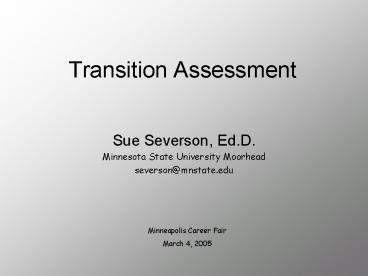Transition Assessment PowerPoint PPT Presentation
1 / 33
Title: Transition Assessment
1
Transition Assessment
- Sue Severson, Ed.D.
- Minnesota State University Moorhead
- severson_at_mnstate.edu
Minneapolis Career Fair March 4, 2005
2
IDEIA, 2004
- The term transition services means a
coordinated set of activities for a child with a
disability that - (B) is based on the individual
childs needs, taking into account the childs
strengths, preferences, and interests. . . .
3
IDEIA, 2004
- Appropriate Measurable Postsecondary Goals
- Based upon age appropriate transition assessment
- Related to training, education, employment and
where appropriate independent living skills
4
Transition Assessment Planning
Teaching of skills/knowledge (goals objectives,
general education curriculum)
Initial Identification of Needs
Transition Planning
In-Depth Assessment of Select Areas
Linkage to services/supports (activities)
Adapted from Transition Planning Inventory, Clark
Patton, 1997.
5
Questions Transition Assessment Must Answer
- What are the desired future outcomes/goals?
(preferences and interests) - Results oriented process.
- Needs, strengths, preferences and interests.
- What skills does the student possess? (strengths)
- Relative to their goals.
- What skills must the student acquire to achieve
their goals? (needs) - What planning issues need to be addressed?
(needs)
6
Postsecondary Goals (preferences interests)
ASSESS
Course of Study
Present Level Of Educational Performance --------
------- Build on strengths, address needs
Statement of Needed Transition Services
ASSESS
Goals Objectives
7
Transition Assessment
- Key piece of the preparation for life puzzle
- Systematic observation of what individuals need
to function successfully as adults - Systematic observation--objective and organized
means of gathering data to confirm or validate
(DCD Manual)
8
Transition Assessment Instruments
- ESTR Scales
- ESTR-J-R Parent Form
- Transition specific assessment for students with
mild disabilities - ESTR III Parent Form
- Transition specific assessment for students with
more disability - Transition Planning Inventory (TPI)
- Transition screening for students with mild
disabilities - LCCE Batteries (Published by CEC)
- Knowledge Battery-200 multiple choice test
- Performance Battery-Performance-based measures
- Brigance Diagnostic Inventory of Employability
Skills - Criterion referenced performance-based assessment
- Brigance Diagnostic Inventory of Life Skills
- Criterion referenced performance-based assessment
9
Transition Planning Inventory (TPI)
- Four forms home, school, student, profile
- 46 transition planning statements
- 9 planning areas
- Employment, Further Education/Training, Daily
Living, Leisure Activities, community
Participation, Health, Self-Determination,
communication, Interpersonal Relationships
10
Transition Planning Inventory (TPI)
- Screening?
- Broad items
- Manual contains further breakdown
- Mild Disabilities?
- Authors indicate it can be used for all
- Early Years?
11
TPI Profile
12
Measurable Postschool Outcomes
- Student form
- Parent form in manual
- 15 open ended statements
13
Enderle-Severson Transition Rating Scales
- ESTR III
- ESTR III Parent Form
- ESTR-J-Revised
- ESTR-J-Revised Parent Form
- Transition Planning in the Schools Using the
Enderle-Severson Transition Rating Scales, 3rd
Edition
14
ESTR III
- Items reflect the original scale (published in
1991). - 5 transition areas-
- Employment, Recreation Leisure, Home Living,
Community Participation, Post Secondary Education
- Areas are inclusive of the areas identified in
IDEA - Useful when assessing students with more
disability.
15
ESTR-J-Revised
- Reduced number of items from ESTR-III.
- Same 5 transition areas-
- Employment, Recreation Leisure, Home Living,
Community Participation, Post Secondary Education
- Areas are inclusive of the areas identified in
IDEA - Useful when assessing students with MILD
disabilities.
16
ESTR-J-Revised Administration
- Respondents
- Parent Form (gray form)
- Rating system
- YesIndependent and Consistent
- No Not performed or performed inconsistently.
17
(No Transcript)
18
Brigance Life Skills Inventory
- Provides performance-based assessment to
determine students strengths/needs - Does not assess Postsecondary Goals (Future
Outcomes) - Is not organized around the five transition areas
- Does not assess planning issues
- But-it DOES provide performance based assessment
of student skills
19
(No Transcript)
20
(No Transcript)
21
(No Transcript)
22
LCCE Knowledge BatteryLife Centered Career
Education
- Published by CEC
- 200 Multiple Choice Test
- Percentile rank
23
LCCE Knowledge BatteryLife Centered Career
Education
- 3 Curriculum areas
- Assesses Daily Living Skills, Personal Social
Skills, Occupational Skills - Broken down into 22 competencies
- Broken down into 97 subcompetencies
24
LCCE Knowledge BatteryLife Centered Career
Education
- 10 questions for each competency
- What the student knows in comparison to peers
- Not what the student does on a daily basis
25
LCCE Performance BatteryLife Centered Career
Education
- Nonstandardized criterion referenced measure of
LCCE competencies - Performance based assessment
26
Budgeting
27
Medical Symptoms
28
Attendance Punctuality
29
Sitlington, Clark, and Kolstoe (2000)
The most central and critical use of transition
assessment information is as a component of the
Present Level of Educational Performance in the
students IEP. Transition goals and objectives,
along with official linkages with nonschool
agencies, would come directly from
transition-referenced assessment and the
information in the Present Level of Educational
Performance. The data should have direct
implications for instructional program decisions,
including program design, program placement,
curriculum planning, instructional procedures,
and additional assessment requirements. ( p. 123)
30
Time Flies
31
We have all of our ducks in a row.
32
Transition-Weve created a good fit. All the
pieces are coming together.
33
Because of our preparation

